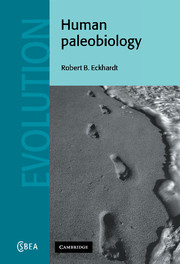Book contents
- Frontmatter
- Contents
- Preface
- Acknowledgments
- 1 Paleobiology: present perspectives on the past
- 2 Constancy and change: taxonomic uncertainty in a probabilistic world
- 3 A century of fossils
- 4 About a century of theory
- 5 Human adaptability present and past
- 6 Primate patterns of diversity and adaptation
- 7 Hominid phylogeny: morphological and molecular measures of diversity
- 8 Plio-Pleistocene hominids: the paleobiology of fragmented populations
- 9 Character state velocity in the emergence of more advanced hominids
- 10 The paleobiology of widely dispersed hominids
- 11 Paleobiological perspectives on modern human origins
- 12 A future for the past
- Bibliography
- Index
6 - Primate patterns of diversity and adaptation
Published online by Cambridge University Press: 18 December 2009
- Frontmatter
- Contents
- Preface
- Acknowledgments
- 1 Paleobiology: present perspectives on the past
- 2 Constancy and change: taxonomic uncertainty in a probabilistic world
- 3 A century of fossils
- 4 About a century of theory
- 5 Human adaptability present and past
- 6 Primate patterns of diversity and adaptation
- 7 Hominid phylogeny: morphological and molecular measures of diversity
- 8 Plio-Pleistocene hominids: the paleobiology of fragmented populations
- 9 Character state velocity in the emergence of more advanced hominids
- 10 The paleobiology of widely dispersed hominids
- 11 Paleobiological perspectives on modern human origins
- 12 A future for the past
- Bibliography
- Index
Summary
Introduction
The previous chapter presented the broad framework developed by human biologists for the interpretation of variation in living populations of our species. This chapter examines the comparative perspective provided by studies of some nonhuman primate populations. Its major objective is to demonstrate that the same interpretive framework that has proven to be so powerful in understanding patterns of variation in living humans also can be extended to extant primate taxa.
Our taxonomic order, which includes apes, monkeys and prosimians as well as humans, is unusual among existing mammals in its remarkable biological diversity. Primates are among the most ancient group of placental mammals to have evolved, with some early members having contributed to the mammalian adaptive radiation about 100 million years ago. Over this enormous timespan, primate populations have become so anatomically and behaviorally differentiated that it is difficult to find many characteristics that all share in common. For the most part, however, the earliest and latest species to appear are linked by common trends – for example, reduction of the apparatus of smell, elaboration of the visual system, and progressive expansion of the brain – running through a series of intermediate forms. Perceiving this pattern over a century ago, Thomas Huxley remarked (1863:98), ‘Perhaps no order of mammals presents us with so extraordinary a series of gradations as this – leading us insensibly from the crown and summit of the animal creation down to creatures, from which there is but a step, as it seems, to the lowest, smallest, and least intelligent of the placental Mammalia.’ As suggested by their anatomical distinctions, primates also are adaptively diverse.
- Type
- Chapter
- Information
- Human Paleobiology , pp. 116 - 141Publisher: Cambridge University PressPrint publication year: 2000



